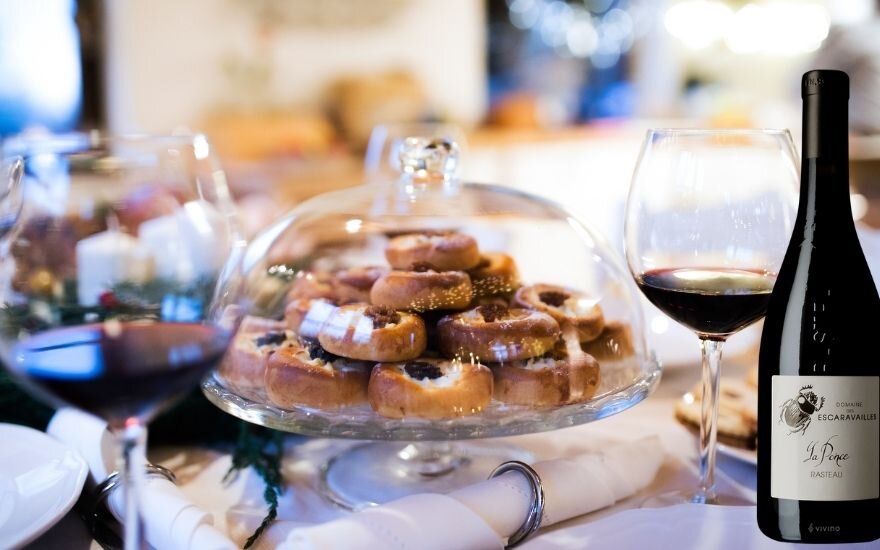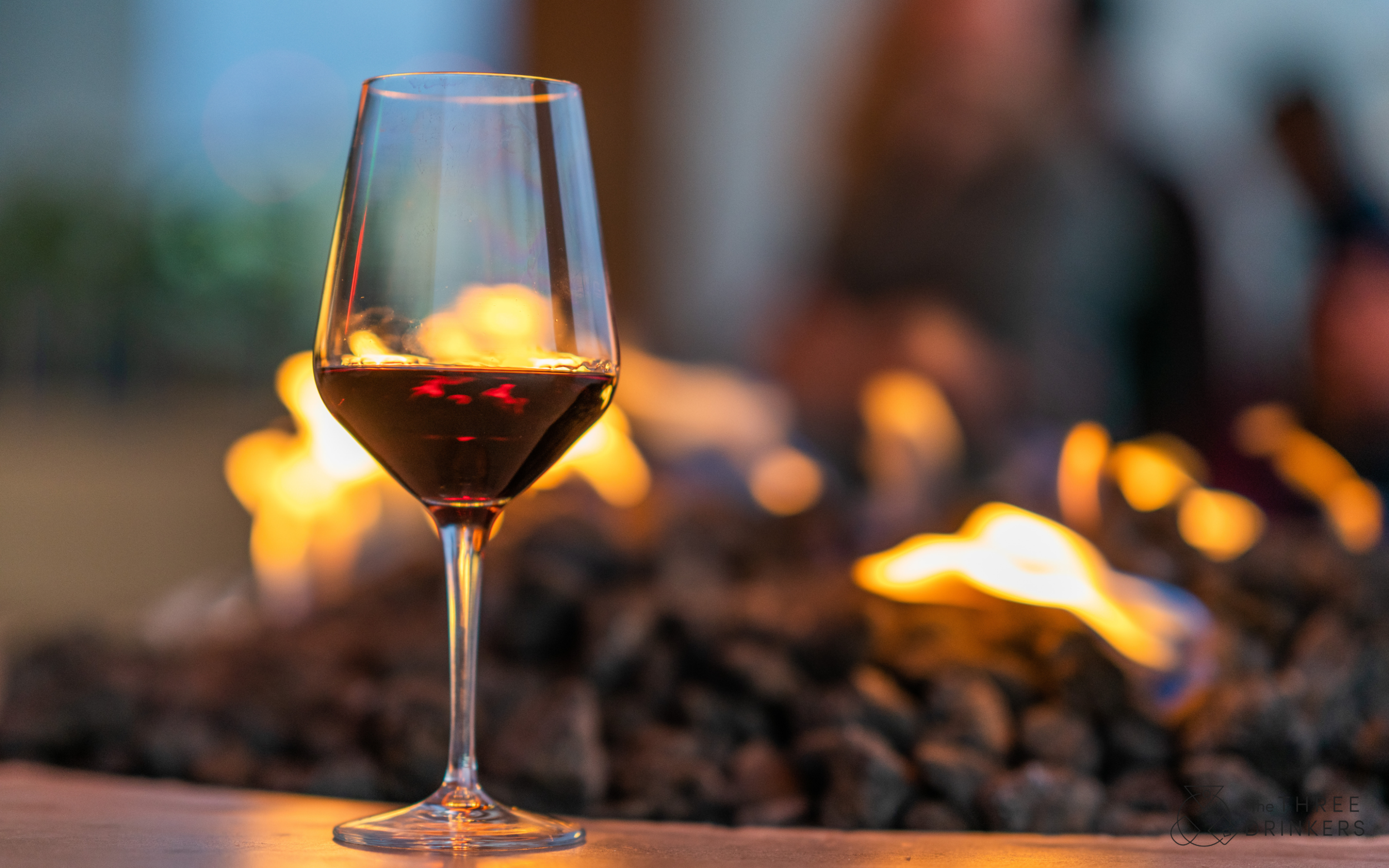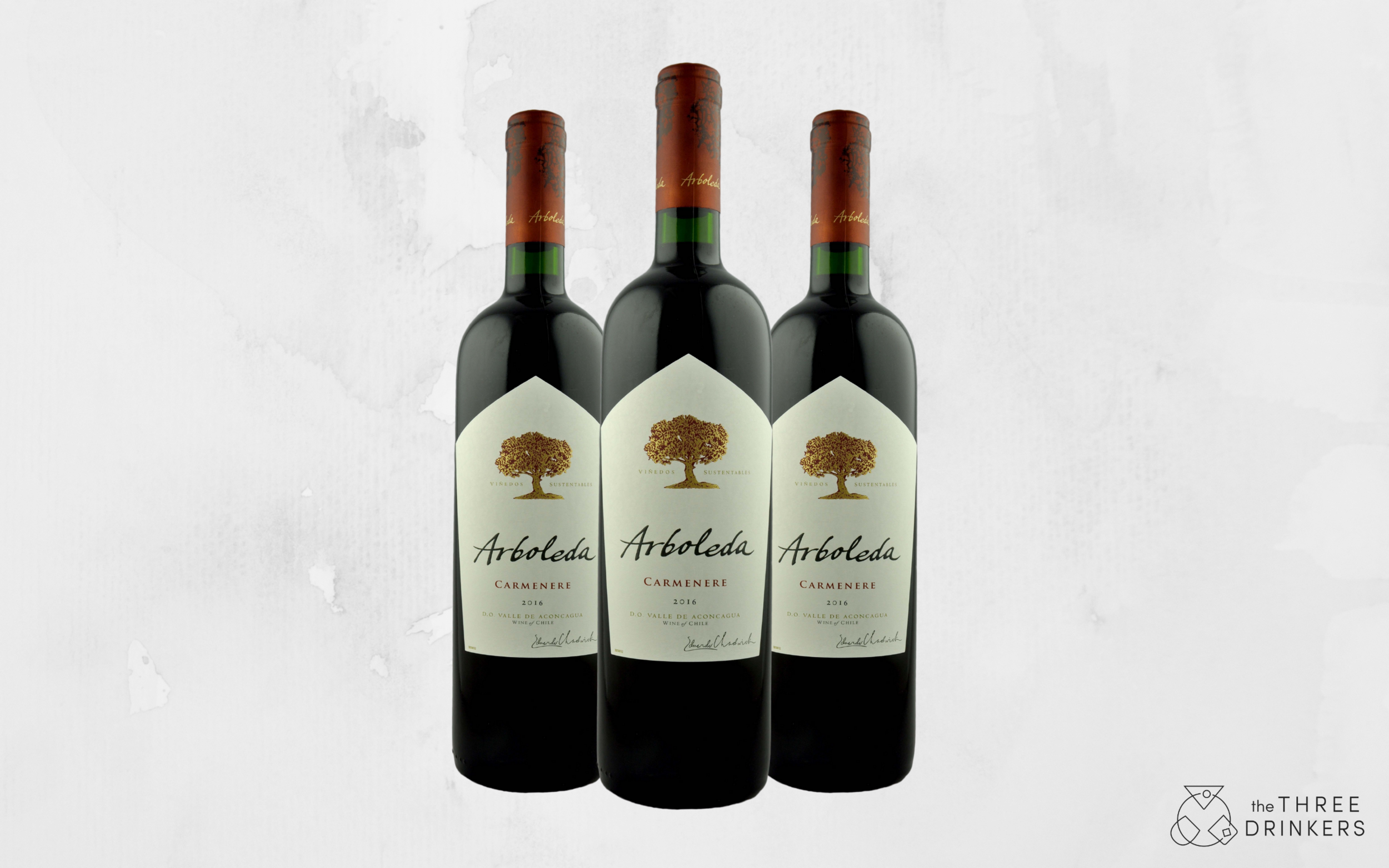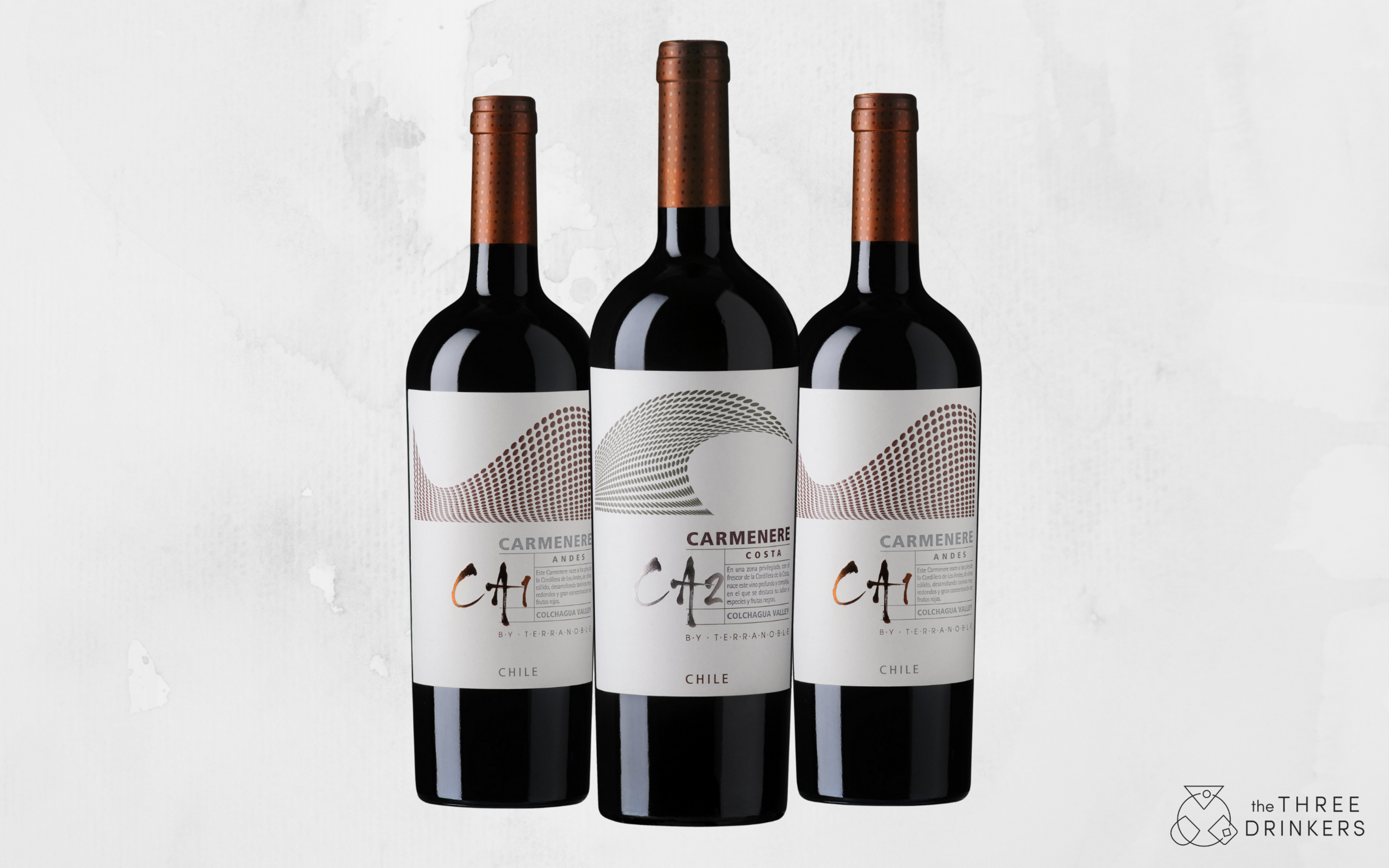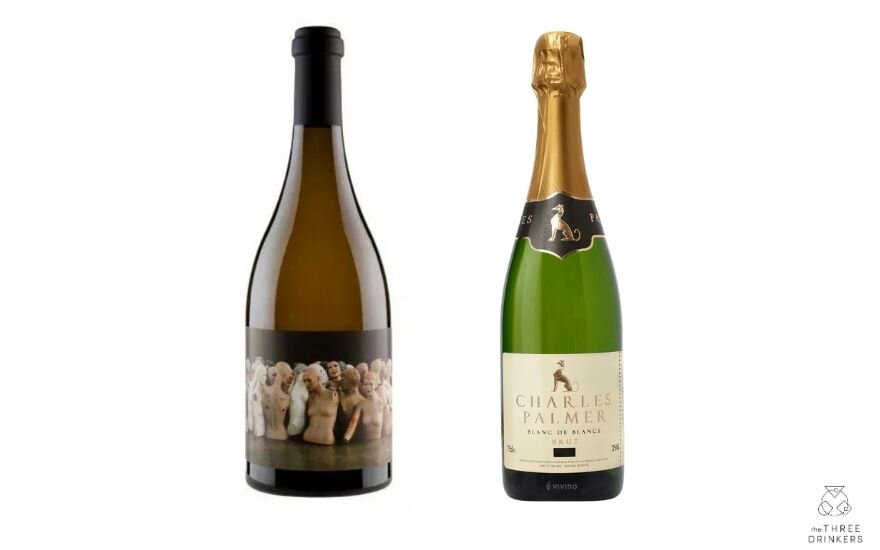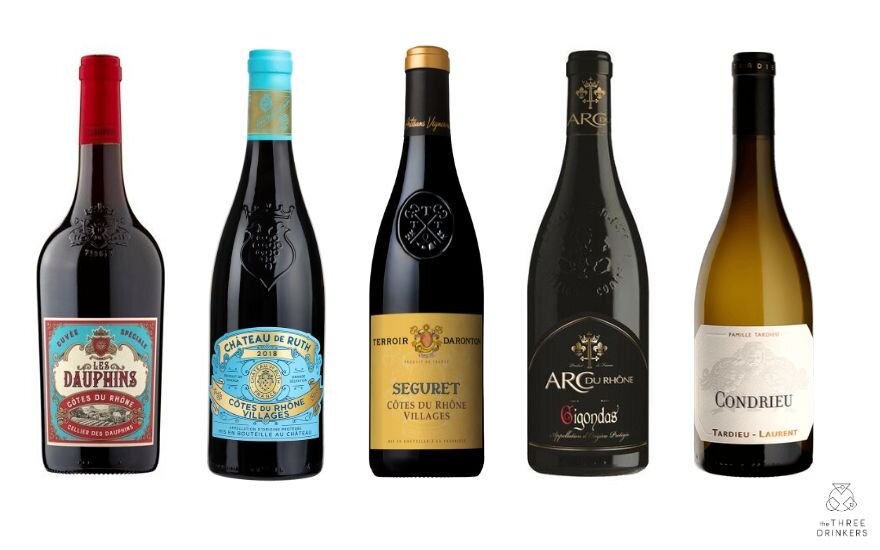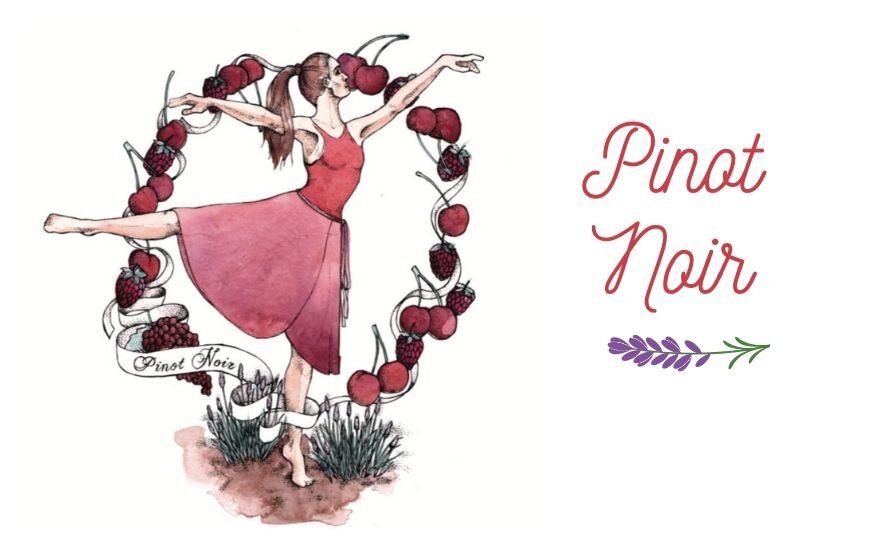Don't ignore Sherry because you once tasted the sweet stuff your Nan drinks. Real Sherry is a whole world of moreish deliciousness! In this video, Helena answers the big questions: What is Sherry? What makes Sherry unique and what are the keys styles of Sherry? All with Russian dolls with beards and a nice Vinalogy about a choir. And a dog. Happy Sherry Week! #SherryWeek
Rasteau: Your New Go-To Winter Red!
Words by Helena Nicklin
What have Harry Styles, Robbie Williams and Rasteau AOC wine got in common?
You may have seen our One Minute Wine Ace piece on Côtes du Rhône recently, which likens this much-loved, southern French blend to a famous boy band, where each grape brings a particular personality to the mix. Well if Côtes du Rhône is the One Direction or Take That of wine, then Rasteau AOC is Harry Styles or Robbie Williams; the charismatic one gone solo to forge a brilliant career of their own.
Located in the south-facing hills of France’s southern Rhône Valley, Rasteau was one of the 22 named villages forming part of the acclaimed ‘Côtes du Rhône Villages AOC’ appellation until its status was promoted further in 2010, elevating it to ‘Cru’ status with an AOC in its own right. AOC stands for Appellation d’Origine Controllée, which is a wine producing area with strictly controlled rules aimed at preserving quality. AOC is a step up from being a single part of Côtes du Rhône Villages AOC and Rasteau winemakers are deservedly very proud of their burgeoning solo career.
What is Rasteau AOC wine like? Christmas cake in a glass!
AOC Rasteau is for red, still wines only from approved parcels of vines. These reds are full-bodied and rich with concentrated bramble fruit, violet and cooking spice aromas and flavours along with spirity, dried fruit notes. They must be made with at least 50% Grenache which thrives in the poor soils of Rasteau, especially from the old vines there. Syrah and Mourvedre must also form at least part of the blend, but not more than 50%. Other southern French varieties such as Carignan may also be added to the blend for structure too.
It’s an appellation to get to know because it’s from that beautifully reliable part of France that makes rich, but not over-blown reds that are very accessible; a region for ‘every day hedonists’ like us, with wines that drink well when young, vibrant and fruity as well as being able to age impressibly well. The same can be said for Harry Styles, in case you were wondering.
Rasteau Wine Food Match
The rollicking reds of Rasteau were made to go with food. They love it and are so versatile! Whether it’s meat, from game to beef stew, cheese, cold cuts, grilled veg or even, dark chocolate fondant and lightly spiced Asian cuisine, Rasteau can handle a lot of flavours.
Why do I think Rasteau is sweet wine?
A fair question, as sweet wines in Rasteau go back a long way! In the 18th century, when the area under vine here was the largest in the Vaucluse, naturally sweet wines were the order of the day though there were dry wines too. After the phylloxera epidemic which decimated vineyards, Rasteau winemakers went back to producing naturally sweet wines, a.k.a. Vins Doux Naturels, or VDNs around 1935. You may also have heard of AOC Rasteau Rancio; a sticky brown VDN that has been exposed to oxygen and light in wooden barrels for up to two years. This new wave of post-war, sweeter wines were lauded enough to be granted their own AOC status while the dry wines of the village itself continued simply as part of the Côtes du Rhône appellation. It wasn’t until 1966 that the dry, still, red wines began to catch up, being elevated to ‘Côtes du Rhône Villages’ status, before earning their AOC ‘Cru’ status just ten years ago in 2010, effective from the 2009 vintage.
Is Rasteau wine expensive?
The beauty of Rasteau is that it can feel hedonistic and indulgent, but doesn’t have to break the bank. You can get some very drinkable, easy-going Rasteau wines from around £10 but equally, if you want to go more premium for a special occasion or a gift, there are some seriously smart ones too. Below is a selection of hand-picked Rasteaus (Rasteaux?!) that cover all bases. Pop the cork and pour yourself a slice of Christmas cake...
Rasteau Tasting Tour
Domaine Escaravailles ‘La Ponce’, Rasteau 2017
A fabulously rich, fruity and well-structured wine with spice and a good bit of age on it. For the price, it’s a steal! Quite high in alcohol, so definitely one for those wintery meat stews or roast beef.
Find it for £9.99 from The Wine Society
M. Rasteau, Chapoutier, 2019
A youthful, concentrated and relatively simple red (in a good way), with vibrant forest fruit notes and a hint of spice. Lovely alone or with charcuterie and cheese.
Find it for £13.78 from gourmethunters.com
Rasteau 'L'Andéol', Famile Perrin, 2017
Made from 70-year-old vines by arguably the most famous family in the Rhone Valley, the Grenache and Syrah shine here with notes of dried herbs, dark plum and some ripe red fruit. Voluptuous and silky, this stands out in its price range. Another big food wine or one for by the fire.
Find it for £14.99 (mix six price) at Majestic
Chateau de la Gardine, Rasteau 2017
The one in the very quirky bottle! No, your eyes do not deceive you and neither will your palate. Big, bold and well-structured, this wine is showing its tannins, which are softening beautifully with age. Leathery and peppery, with notes of dark cherry, damson and violet, I’d have it with cheese or meat and get it in a decanter to air for a while before drinking. You will be rewarded!
Find it for £17.95 from Gerrard Seel
Domaine La Luminaille, Rasteau ‘Luminaris’, 2017
Find it for £19.99 from winebuyers.com
One Minute Wine Ace: Tempranillo
In the early hours of the morning, you spot him from your window. He’s back: the mysterious cowboy. The man is a legend in these parts and each town has a different name for him. You watch this alluring figure in faded leather boots as he unsaddles his horse. You spoke to him once: his voice was soft as velvet and sweet, like wild strawberry. He smelled of wood smoke mingled with fresh, vanilla tobacco. It has been a long time. He has aged well.
Introducing Tempranillo, the early-ripening grape (‘temprano’ is Spanish for ‘early’) with notes of wild strawberry and liquorice, often tempered by cinnamon spice and leather from years of ageing in oak barrels. The result is a mellow, spicy wine that’s moreishly chewy. Think of comfortable, worn leather, tobacco and stewed strawberry fruit. Without the oak though, it’s rustic and medium bodied with ripe, bright red fruit. It’s very easy to love!
Fact!
While Tempranillo is now found all over the world, it has always been the flagship red grape of Spain, where it is responsible for 88% of vine plantings. It is the principal grape used in red wines from the famous Rioja and Ribera del Duero regions too. Our cowboy has many aliases, however, even in Spain where it’s also known as Tinto Fino, Cencibel, Ull de Llebre and Tinta del Pais. You may see it in Portugal too as Aragonez or Tinta Roriz. Who said wine was complicated?
Food Match
Tempranillo can handle earthier meats like roast lamb with lots of garlic, or anything with a tomato base, like lasagne. Barbecued meats in general work nicely as do grilled vegetables. It’s the smoke.
Helena’s oldie but a goodie. This time, you’ll remember what you learned!
TASTING TOUR
Tempranillo 1: Rioja
When you think of Tempranillo, your first thought should be Spain. Head straight to the region of Rioja and start with the younger versions before working your way up the age ladder: go from Joven (meaning ‘young’ in Spanish) to Crianza, then Reserva and, finally, Gran Reserva. The difference is the amount of time the wine has aged in oak and then in bottle before release. Both bottle and oak age increase as you move up the scale.
Try La Rioja Alta ‘Gran Reserva 904’, 2011
This fantastic producer hails from the Rioja Alta, Rioja’s largest subregion, where the Tempranillo is perfectly suited to the cooler climate thanks to the Atlantic climate and higher altitude. The 904 is only made a few times each decade and the 2011 version shows beautiful concentration with a perfume of tobacco, dark fruit, spice and prune. On the palate, it’s full but refreshing with fabulous ripe and dried fruit notes and a cool acidity. Worth splashing out on for Christmas!
Find it for £50 a bottle from Armit Wines and other retailers.
Tempranillo 2: Ribera del Duero
Stay in Spain, but mosey on over to Ribera del Duero: an exciting area for Tempranillo where wines traditionally have more body and power than those from Rioja thanks to slightly different geography.
Try Psi Bodegas y Vinedos Alnardo 2017
The modern wine world meets tradition here in this powerhouse of a wine from one of Ribera de Duero’s most celebrated winemakers, Peter Sisseck. Concentrated, brooding and intense, with lush, dark fruit tannins and spice. It’s the iron fist in the velvet glove.
Find it at Corneyandbarrow for £27.25
Tempranillo 3: Douro
In Portugal’s Douro region, Tempranillo is known as Tinta Roriz. It’s one of the principal blending grapes in Port, but is now also making some stunning, still, dry wines that simply must be tasted.
Try Castrum Douro Red
Made by renowned producer Quinto do Crazto, this Tinta roriz wines shows what brilliant value Portuguese red wines can be. Think plum pudding in a glass with caramelized raisins. Delicious!
Find it at CO-Op for £10
Tempranillo 4: Australia
Various regions in Australia are now producing some delicious, juicy, red-fruited Tempranillo from the Margaret River region in the West all the way over to the Barossa Valley in the East.
Try The Hedonist Tempranillo, McLaren Vale
This one from McLaren Vale is meant to be a more youthful, soft and juicy style, with vibrant red fruit and liquorice flavours.
Find it at Fareham Cellars for £15.50 a bottle
Like this One Minute Wine Ace? Try our other pieces for Chardonnay, Cabernet Sauvignon and One Minute Wine Ace: Pinot Noir, One Minute Wine Ace: Sauvignon Blanc and Cotes du Rhone.
Carmenère: Smoky Sorceress of Wine Grapes
Words by Helena Nicklin
Carmenère is a red grape that has really upped its game in the last few years. Fans of Cabernet Sauvignon will appreciate its similar, brooding, blackcurrant leaf flavour profile but Carmenère tends to be juicier and less tannic than Cabernet Sauvignon with a characteristic cocoa and bell pepper notes on the finish. Dark purple, velvety and smoky, throwing herbs into the cauldron, Carmenère has always been the smoky sorceress of wine grapes to me.
Much like Malbec in Argentina, Carmenère came over to South America from Bordeaux when French immigrants settled there in the 1800s. For years it was believed to be Merlot but it eventually was discovered for what it was and has only been an officially recognised varietal in Chile, its new spiritual home, since 1998. It never thrived in its original home of Bordeaux where it struggled to get ripe and after the phylloxera vine infestation of 1870s, most of the vines there were ripped out. Chile had the right combination of weather and soils however to let the grape show its potential. For years it made relatively inexpensive, juicy, dark red wines in Chile that were easy to drink but not all that complex. Nowadays, Chilean Carmenère is getting the full terroir treatment, with higher quality wines from specific microclimates really showing what this grape can do. According to winemaker Marcelo Garcia at TerraNoble winery in Chile, a Carmenère plant takes around 12-15 years to truly shine, when it starts to make wines that have more structure and fewer vegetal notes.
Fact: The name Carmenère comes from the French word for crimson, which is ‘carmin’, thanks to its bright red leaves at Autumn time.
Fact: Carmenère is also often spelled with two accents: Carménère. Chile tends to only use one.
Carmenère Food Match
The smoky, leafiness of this grape makes it a great match for earthy meats like roast lamb and grilled vegetables. It loves anything that’s been on a barbecue!
Chilean Carmenère Tasting Tour
Co-op Irresistible Carmenère
From the warm, inland appellation of the Maipo Valley, this cheap and cheerful wine is a classic example, packed with notes of ripe blackcurrant, vanilla spice and green pepper. Smooth velvety. It packs quite a punch.
Find it here at Co-Op for £7
Arboleda Carmenère 2016
A rich, bramble-fruit and chocolatey number hailing from the inland Aconcagua region that is a step up in structure and complexity. Silky smooth, but big enough to handle lots of meat. You might always want to try this with some dark chocolate! There are not many wines you can say that about!
Find it at Corneyandbarrow.com for £16.95
Costa Vs Andes
TerraNoble is a winery becoming known for championing Carmenère and creating high-end wines with it. They have an exciting project where they are comparing Carmenère from Los lingues the bottom of the Andes with some from Lolol, by the coast. What they have found is that the Andes (CA1 Andes) wine is riper, fuller-bodied and richer with more classic typicity than the cooler, coastal wine (CA2 Costa), which shows crunchy red fruit notes, fewer green flavours and generally, a finer structure and more precision. Try them side by side to see what this grape can truly do.
Find CA1 Carmenère Andes 2014 at vintageroots.co.uk for £27.30 (2017 on its way)
Find CA2 Carmenère Costa 2017 at vintageroots.co.uk for £27.30
Love wine? Then make sure to check out our 5 Reasons to try Garnacha and From Budget to Blowout: 7 Outstanding Champagnes.
One Minute Wine Ace: Cabernet Sauvignon
You can generally presume that all professional, male rugby players have certain elements in common: they are full in body, fairly heavy and well structured. There are forwards who pack a slightly bigger punch and backs who are a tad more refined and lean, but generally speaking, you can always tell a rugby player a mile off, no matter where in the team they play. It’s the obvious build and all those purpley-black bruises that do it! And with all their years of training and experience, you can take a bet that their playing quality is going to be pretty reliable, no matter which country it is that they play for. They also tend to need a few years to chill out and mellow…
Yes, Cabernet Sauvignon is the professional rugby player of the wine world. This heavy-duty grape variety has the thickest skin of all the grapes, giving it lots of tooth-drying tannin and plenty of brawn! ‘Cabernet’, as it’s often known, is a hardy, well-structured grape that makes pretty reliable wine just about anywhere. This is why you can find it all over the world now. When at its very best, it can sometimes take a few years to mature, so bear that in mind when you’re picking one out. Look for a concentrated, dark blue-black and purple colour with distinctive, spicy blackcurrant and cedar flavours. In some cases, you’ll also spot a telltale minty or eucalyptus note, which is often a hint that it’s from a warmer climate.
CABERNET SAUVIGNON TASTING TOUR
Cabernet Sauvignon makes pretty reliable wines from many places globally, but here are four key styles to start your journey with,
Cabernet 1: Be prepared to spend some cash and head to Bordeaux, France: the Old World home of Cabernet, where it’s usually blended with Merlot among other grapes. Look for one from the Left Bank of the river Gironde for a classic earthy, cedary number that’s Cabernet dominant. Heard of Chateau Margaux? That’s a Cabernet-dominant, Left Bank Bordeaux wine.
Try: Château de Lamarque, Haut-Medoc, 2015 for £22.95 from Corneyandbarrow.com.
Cabernet 2: Compare your Bordeaux with a Cabernet Sauvignon from Coonawarra in Australia for a fuller-bodied, juicier version with tonnes of ripe blackcurrant and a characteristic mint and eucalyptus twang. Coonawarra is one of Cabernet’s classic, New World homes.
Try: Wakefield Jaraman Cabernet Sauvignon for £17.99 or £15.99 mix six price from Majestic.
Cabernet 3: At a similar price and standard to Bordeaux, you could also try some serious Cabernets from Napa Valley, California for a style that is somewhere between the two above: big wines made in a Bordeaux style, but with a pleasing extra dollop of fruit.
Try: Illustrious Cabernet Sauvignon 2018, £36 a bottle or £32.40 mix 6 price from Laithwaites.
Cabernet 4: For something a little more entry-level price wise, check out what they can do with Cabernet over in the warm Colchagua Valley in Chile. Here, Cabernets are about full-on, sweeter, blackcurrant-scented wines with a savory, smoky kick. You can get some great ones for £6 or so but there are also some super-serious wines coming out of Chile too.
Try: Montes Reserve Cabernet Sauvignon, Chile, £9 from Coop.
Like this? Try our other One Minute Wine Ace articles on Pinot Noir, Chardonnay, Cotes du Rhone and Sauvignon Blanc.
One Minute Wine Ace: Chardonnay
Words by Helena Nicklin
Weren’t there always at least four people in your class with the same first name at school? In my year, it was Kate: fat ones; skinny ones; drippy ones; foreign ones, you name it! Variations on a theme of Kate were popular the world over.
It was hard to work out how to feel about Kates, because just as you had decided that you hated the name because of spotty-faced Kate who smelled of potato, you met supermodel-in-training Kate who had a perm and older friends who could get into nightclubs. Suddenly, you wanted to name all your future children Kate. Even the boys.
Well, Chardonnay is the wine version of Kate. The sheer number of styles you’ll find worldwide can make it difficult to pin down your thoughts on it. After all, nearly every wine-producing region in the world has a go at growing it! And as styles of this wine go, Chardonnay moves from the sublime to the ridiculous, being responsible for some of the greatest white wines in the world. Climate and winemaking techniques may leave their mark, but the key elements will always be there somewhere: look for a golden colour, ripe melon flavour and a fuller body than many other white varieties such as Sauvignon Blanc. Vanilla and buttery notes are also good indicators that the wine is a Chardonnay. Try it unoaked for a true reading of its merits.
Tasting Tour
Wine regions all over the world are making wine with Chardonnay, but here are some keys styles to try first. Taste them together (in moderation, of course) and then go out and explore the world of Chardonnay! One thing to bear in mind with Chardonnay: what you pay for is very much what you get.
Chardonnay 1: Chablis, France. Yes, Chablis is always made from Chardonnay. It’s just named after the region in northern France rather than the grape, as often happens in Europe. Don’t be that person who ‘loves Chablis but hates Chardonnay! Chablis has a particular style that’s lean, mineral and elegant, thanks to the very cool climate there and its famously chalky soil. If it were a Kate, it would be Kate Moss, the catwalk model. Start with a Petit Chablis, then a straight Chablis before working up to the Premier Cru and Grand Cru Chablis wines, which are fabulous, but a bit richer and often have a touch of oak - getting towards the classic ‘Burgundian’ style of Chardonnay (see below). Chablis, by the way, is technically part of the greater Burgundy region, but it’s slightly removed, just to the north west of Burgundy ‘proper’ and while it’s all still Chardonnay for the whites, the styles are distinctly different.
Try: Chablis, Domaine Louis Moreau. £17.99 Ocado
A great producer making classic Chablis. Lean, chalky and refreshing. Excellent with seafood.
Chardonnay 2: Burgundy, France. The greater Burgundy region in France also has its own style that tends to be fuller-bodied, with more fruit and savoury oakiness than Chablis. Golden, complex and sophisticated, this is the Kate Winslet of wine. The oscar winner - statuesque and structured, with a lot to say. Burgundy (Bourgogne in French) is one of the world’s most famous regions for Chardonnay. It’s also a region with many villages, the names of which will be shown on the label in large letters - villages you may have heard of like Puligny-Montrachet or Macon or Meursault. These still fall under the general umbrella style of Burgundy as I’ve described but each will have their own nuances thanks to their specific geography.
Try: Domaine Carrette, Pouilly Fuissé 2017. £22.95 from CorneyandBarrow
A popular style from the Maconnais in southern Burgundy. Rich, ripe fruit and spice with refreshing acidity.
Chardonnay 3: Mornington Peninsula, Australia. The country that put Chardonnay on the map for a new generation is doing incredible things with this grape, especially from the relatively cooler parts, like Mornington Peninsula in the south and Margaret River on the coast in the west. Think exotic, ripe fruit with a zingy freshness. It’s a million miles away from those cloying Chards of the early ‘90s.
Try: Ten Minutes by Tractor, Estate Chardonnay, 2015. £36 mix six price from Majestic.
The is the Cate Blanchett of wine styles: cool and restrained, this is an elegant Chardonnay with plenty of structure. Made in a Burgundian style with French oak but showcasing an extra dollop of pure fruit.
Chardonnay 4: California, USA. The best Californian Chardonnays are like actress Kate Hudson: golden, curvy California girls with brains, capable of fun as well as complex roles, and everyone wants them at a party. Napa and Sonoma are the places that fly with it.
Try: Mannequin Chardonnay 2017, Orin Swift. £46 from winebuyers.com
Brilliant, mind-boggling label aside, this Chardonnay is multi-layered with notes of melon, honey and nectarine supported by a well-integrated oak spice. Velvety and mouth-filling, it’s a real head-turner.
Chardonnay 5: Blanc de Blancs Champagne or Sparkling Wine. ‘Blanc de Blancs’ with fizz usually means it’s made from 100% Chardonnay and the style is more ethereal, fine boned and delicate in its youth than the wines traditionally blended with the red Champagne grapes (Pinot Noir and Pinot Meunier). With age, it puts on weight and becomes deliciously creamy and rich.
Try: Charles Palmer Blanc de Blancs 2014, £26.10 on offer from charlespalmer-vineyards.co.uk
Incredible value bubbles with some age on them. Deliciously creamy thanks to extra lees ageing. Would be lovely with seafood and anything umami, like parmesan cheese snacks. If it were a person it would be Kate Middleton. Elegant and English, with porcelain skin…
If you like this, try Helena’s One Minute Wine Ace features on Pinot Noir, Cotes du Rhone and Sauvignon Blanc
Côtes du Rhône: Boyband of wine
Words by Helena Nicklin
Côtes du Rhône wine is many people’s go-to, comforting red wine style but they are not all created equal. Here’s what you need to know with a tasting tour to help you discover...
Where?
The Rhône Valley is a large wine region in the south of France that runs for over 200Km, following the Rhône river, from Lyon to Avignon and beyond. Given the vastly different landscapes from North to South, Rhône Valley wines are split stylistically into two:
The North: from Vienne to Valence, focussing on mainly Syrah for the reds and Viognier for the whites.
The South: ostensibly from Montélimar to Avignon and much wider than the North, its focus is more on blends: Grenache, Syrah, Mourvedre largely for the reds and Grenache Blanc, Roussanne and Marsanne for the whites.
Four quality levels
There are four quality levels of Rhône Valley wine, each naturally going up in price:
Côtes du Rhône AOC: This first level is the largest and covers the whole of the Rhône valley, though around 90% of production comes from the South. It produces almost as much wine as Bordeaux and is focussed on red blends, though there are a few whites and pinks made (2 - 4% of production). Côte’ means ‘bank’, so these are wines made with grapes grown on the banks of the Rhône river.
Côtes du Rhône Villages AOC: Superior in quality to Côtes-du-Rhône AOC with stricter winemaking rules. It’s the second largest appellation in the Rhône.
Côtes du Rhônes Villages + named village AOC: A further step up in quality with even stricter rules and twenty villages have dispensation to write their names on the labels. These names are Rousset-les-Vignes, Saint-Pantaléon-les-Vignes, Valréas, Visan, Saint-Maurice, Rochegude, Roaix, Séguret, Sablet, Saint-Gervais, Chusclan, Laudun, Massif d'Uchaux, Plan de Dieu, Puyméras, Signargues, Gadagne, Sainte-Cécile, Suze-la-Rousse and Vaison-la-Romaine.
The ‘Crus’: Recognised just by their village names, these ‘cru’ are allowed to miss off the ‘Côtes-du-Rhônes Villages’ bit on the label entirely. There are 8 cru AOCs in the North: Côte-Rôtie, Condrieu, Château-Grillet, Saint-Joseph, Crozes-Hermitage, Hermitage, Cornas and Saint-Péray. In the South, there are 9 and they are Vinsobres, Rasteau, Cairanne, Gigondas, Vacqueyras, Beaumes-de-Venise, Châteauneuf-du-Pape, Tavel, Lirac.
The Key Rhône Grapes - the Boyband of Wine styles
The star grapes of the Rhône Valley are Grenache, Syrah and Mourvedre for the reds and Viognier, Roussanne and Marsanne for the whites. In the North, the reds are dominated by smoky, savoury Syrah, whereas in the South, wines are usually blends, led by juicy Grenache, then Syrah and Mourvedre, though there are several other red and white grapes permitted.
Put another way, these Rhône blends are a bit like a boyband, where each key member has been carefully chosen for their particular qualities (and there may be some backing singers on certain tracks). Grenache comes first: the cute, approachable one. Think homemade strawberry jam and liquorice sticks. Syrah comes next: he’s the complex, brooding type who probably writes all the lyrics. Think grilled meat with fresh herbs, pepper and violets. Mourvedre is the party animal of the group. Full-on and full-bodied, he’s unsubtle, rugged and savoury but instantly fanciable. Put them together and the result is harmonious. #Vinalogy.
TASTING TOUR
Côtes du Rhône
Try: Les Dauphins Côtes du Rhône, £8 from Tesco.
Classic, easy going style with juicy, summer fruits and a peppery kick. Excellent value.
Côtes du Rhône Villages
Try: Château de Ruth Côtes du Rhône Villages, Grande Sélection, £10 from COOP .
Available in store, this gorgeous, concentrated, brambly and wild strawberry scented red has had a fabulous label upgrade too so it looks as good as it tastes.
Côtes-du-Rhône Villages + village name
Terroir Daronton Seguret, Côtes du Rhône Villages. £9.75 Waitrose
A seriously decent, easy drinking CDR with a cool salinity that makes it a great match for cold cuts.
Cru Red
Arc du Rhône Gigondas, £16.95 from Ocado
Grenache-led with some Syrah and Mourvedre, this is inky and rich with spicy, grilled meat notes and ripe, red fruit that balances it all up. Needs food!
Cru White
Condrieu, Tardieu-Laurent 2016, £39.95 from Corney and Barrow
Whites don’t get more creamy and luscious than this. Beautifully floral and unctuous with notes of caramelised apricots and white chocolate. Heaven!
If you liked this, try One Minute Wine Ace: Pinot Noir, One Minute Wine Ace: Sauvignon Blanc,
One Minute Wine Ace: Pinot Noir
Words by Helena Nicklin
Pinot Noir: the red grape like a female dancer, graceful and elegant in a cherry silk gown, dancing barefoot in a lavender field. She may be notoriously temperamental and some may find her too thin, but her haunting beauty and ability to make complex moves look so smooth is mesmerising.
Pinot is famously difficult to work with, which is why they can sometimes be a bit hit and miss. When all conditions are perfect and the masters get hold of it however; oh man. You’ll want to bathe in the stuff! Pale in colour, light bodied and elegant, with high acidity and very low tannin, Pinot can taste like a red wine but feel like a white, which is part of its universal charm. Couple this with a sensual, silky texture and an ethereal perfume of spiced cherry, lavender, raspberry compote and earth, and you'll understand why people spend crazy amounts on the top bottles.
FACT: Pinot Noir is one of the three main grapes used in Champagne, along with Chardonnay and the lesser-known Pinot Meunier. If you have a ‘Blancs de Noir’ Champagne, it has been made with the red grapes only: usually Pinot Noir and often with a touch of Pinot Meunier.
PINOT NOIR TASTING TOUR
Pinot Noir loves a cool climate and there are now incredible Pinot Noirs from many places around the globe. These are the classic places to begin your journey however, with some rapidly rising stars to seek out.
Pinot Noir 1: Burgundy, France: If it’s red and from Burgundy (aka Bourgogne), it’s going to be Pinot Noir (99.9%of the time). The best ones need a few years of age on them to develop those ‘haunting’ notes. Think spicy cherry, lavender and marzipan. They’re delicate, earthy, understated and old school in style.
Try: Volnay, Cyrot-Buthiau, £34.95 from Corneyandbarrow.com
Pinot Noir 2: New Zealand is Pinot’s most famous (arguably) New World home. Here, it’s slightly easier drinking and fruit, yet serious. The concentrated, savoury red fruit and cinnamon notes have won hearts and palates worldwide. Head to Central Otago, Martinborough and Marlborough for great ones.
Try: Escarpment Pinot Noir, Central Otago, New Zealand. £25 (£22.95 mix six price) from Majestic.
Pinot Noir 3: California: The fog-cooled parts of coastal California give their Pinots softness, while that ripe, sweet, juicy fruit still shines through. They’re all about strawberries and cream on a bed of red velvet. Look for some from Sonoma County and Russian River Valleys.
Try: Sebastiani Pinot Noir, Sonoma Country, £25 from Dulwich Vintners
Rising Stars
England: Some of our best English wineries have recently started producing some excellent, still Pinot Noirs. Kent and Sussex seem to be particularly strong at this. They’re silky, cool and elegant with fresh red fruit flavours and often, a touch of spice.
Try: Gusbourne, Boot Hill Pinot Noir 2018. £35 from Gusbourne.com
Romania: Romania has a talent for making excellent, inexpensive, seriously easy-drinking cherry-bomb wines from Pinot Noir. Don’t expect the complexity of Burgundy, but for under £10 as they often are, these are rocking value and there are many new ones on the scene.
Try: Sanziana Pinot Noir, Cramele Recas 2018. £8.95 from Corneyandbarrow.
Like this? See our article on the most sought after Pinot Noir, a One Minute Wine Ace feature on Sauvignon Blanc and a more indepth look into Malbec.



